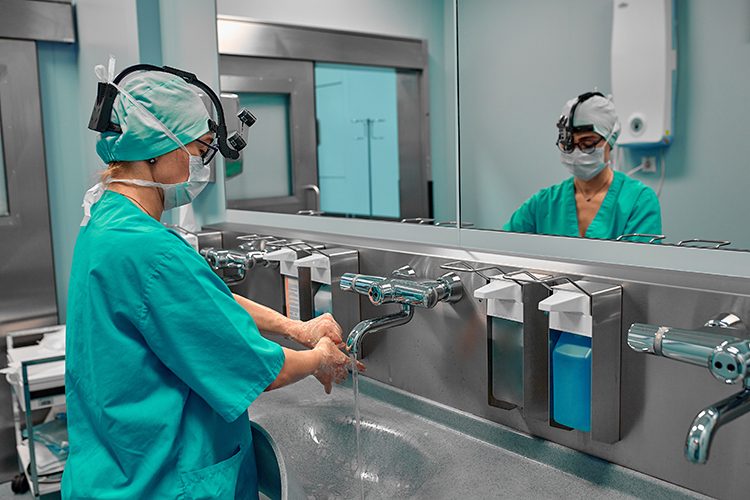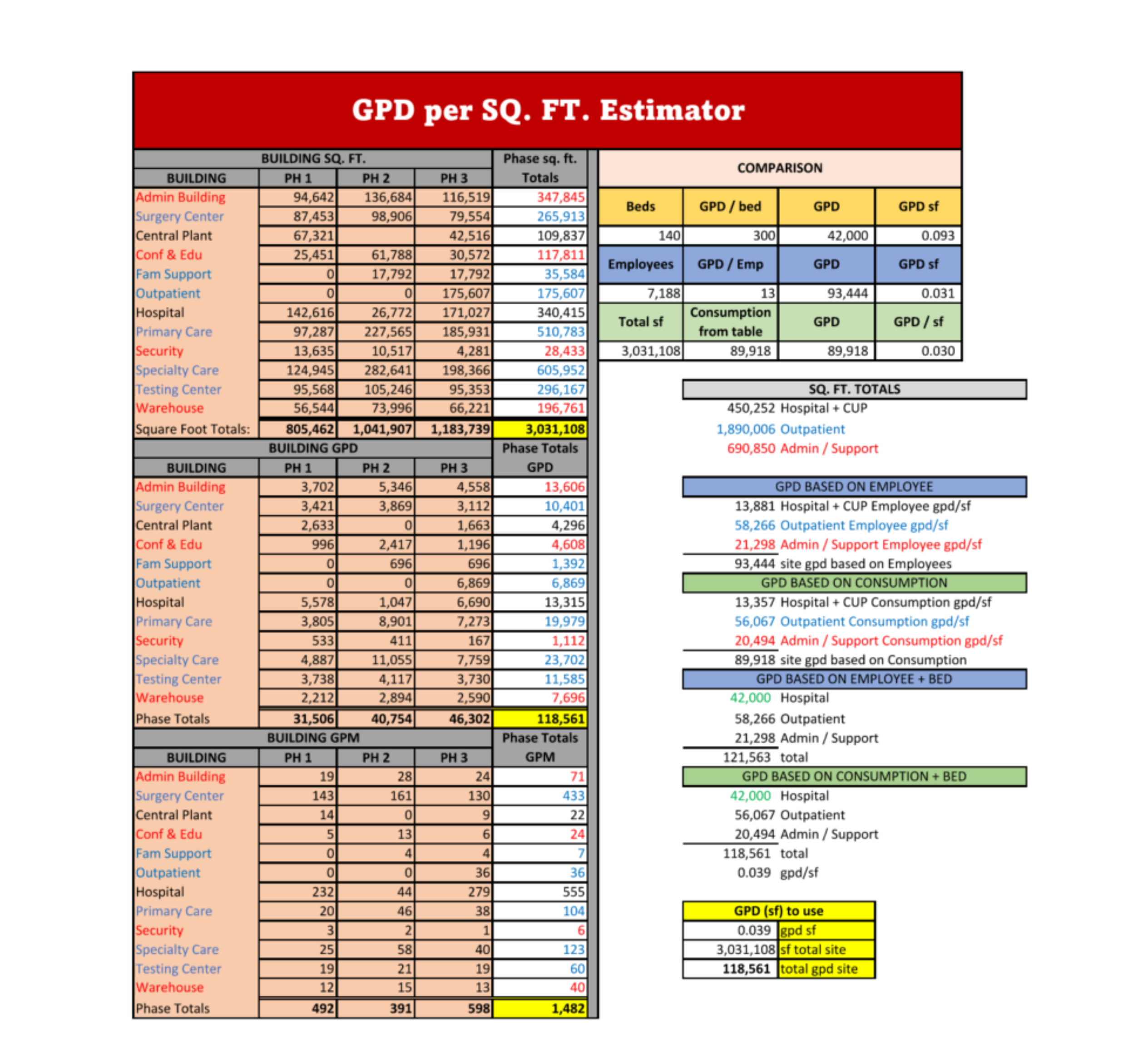Sizing Hospital Campus Domestic Water Needs: A Comprehensive Guide
This is a crucial aspect of infrastructure planning to ensure adequate water supply for various activities and occupants.

In my prior columns from March (https://bit.ly/4biHhrp) and June 2022 (https://bit.ly/4bjxdyp), I explored estimating daily hospital water consumption based on bed counts. However, when dealing with expansive campuses housing multiple buildings, such as a 3 million square foot complex, calculating gallons per day (gpd) becomes more intricate.
On this campus are the hospital and central utility plant, an administration building, outpatient clinic, ambulatory surgical center, medical office buildings and other support buildings.
Sizing domestic water needs for a large campus such as this (with nothing more than square feet and employee count) is a crucial aspect of infrastructure planning to ensure adequate water supply for various activities and occupants.
This column delves into the meticulous process of gauging water requirements for such vast campuses, relying on square footage and employee counts as primary metrics.
Understanding Square Foot GPD Metrics
Square foot gpd metrics serve as the cornerstone for estimating water usage, factoring in occupancy, usage patterns and fixture efficiency to determine daily water demand per square foot.
Factors influencing water demand:
1. Occupancy density. The number of occupants within the campus directly influences water usage for drinking, sanitation and other purposes.
2. Facility types. Different types of facilities within the campus, such as the hospital, medical offices, laboratories, ambulatory surgical buildings, outpatient clinics and other support buildings, have varying water needs.
3. Water fixtures. The presence of water-efficient fixtures such as low-flow faucets, toilets and showers can significantly reduce water consumption, including vacuum waste systems.
4. Outdoor landscaping. Irrigation systems for landscaping and green spaces contribute to overall water demand.
5. Specialized facilities. Facilities such as kitchens, laundry rooms and athletic facilities have higher water requirements than standard office spaces.
To calculate water demand for a 1.5 million-square-foot campus, we first need to establish the square foot gpd for each type of facility or area within the campus. Here are the steps involved (this is only one way to do it).
ASPE Plumbing Design Handbook, Vol. 2, Chapter 8, Private Onsite Wastewater Treatment Systems, includes a table — 8-8, Typical Wastewater Flows from Institutional Sources — where you can use gpd per employee if you know it or use gpd per square foot from the U.S. Energy Information Administration (EIA) Water Consumption Table H8:
1. Identify facility types. Categorize the campus into different facility types based on usage patterns and water needs, such as hospital/central utility plant, outpatient, administration and support.
2. Determine square foot gpd. Assign a square foot gpd value to each facility type based on industry standards, building codes and water usage data. For example:
Office spaces: 0.015 gpd/square foot
Outpatient-type buildings: 0.021 gpd/square foot
Hospital/central utility plant: 0.035 gpd/square foot (or use the 250 to 350 gpd per bed for estimating water needs)
3. Calculate total water demand. Multiply the square footage of each facility type by its corresponding square foot gpd value to determine the daily water demand for that category.
4. Sum total water demand. Add up the water demand from all facility types to obtain the total daily water demand for the campus.
If using bed count for the hospital and central utility plant, you will see a difference in load.

I created a spreadsheet to compare the various methods and depending on which one I used, they were relatively close. I did one for a 3,031,180-square-foot campus (Figure 1), which was either 118,561 gpd or 121,563 gpd, depending on which combined method was used.
Example Calculation
In the comparison box in Figure 1, the orange row is the hospital bed method, the blue row is the employee method and the green row is using the data from the EIA Water Consumption Table H8.
Let’s consider an example calculation for a campus with the following facility types and square foot gpd values:
• 140-bed hospital (250 to 350 gpd/bed): 1 million square feet at 0.035 gpd/square feet (or 250 to 350 gpd/bed)
1 million square feet × 0.035 gpd/square feet = 35,000 gpd (140 x 250 = 35,000 gpd)
• Support buildings: 500,000 square feet at .015 (range is .010 to .025 gpd/square feet)
500,000 square feet × .021 = 10,500 gpd
• Landscaping: 200,000 square feet (irrigation water demand) not considered in the equation
• Total water demand: 45,500 gpd or 45,500 gpd/bed
Design Considerations
1. Storage capacity. Determine the required water storage capacity to meet daily demand, accounting for peak usage periods and emergency situations.
2. Distribution system. Design an efficient water distribution system with appropriate pipe sizes, valves, pumps and pressure regulation devices.
3. Water treatment. Consider water treatment facilities or systems to ensure water quality and compliance with health and safety standards.
4. Sustainability practices. Incorporate water-saving technologies, rainwater harvesting and greywater reuse systems to reduce water consumption and promote sustainability.
5. Regulatory compliance. Ensure compliance with local, state and federal regulations regarding water supply, quality and conservation measures.
Sizing domestic water needs for a 3 million square foot campus requires a systematic approach considering facility types, occupancy, usage patterns and water-efficient practices. By accurately calculating water demand based on square foot gallons per day metrics and implementing appropriate design and management strategies, campuses can ensure reliable water supply, promote conservation and meet the needs of occupants and activities effectively.
Remember, these gallons per day usage factors will be impacted by various design applications such as vacuum waste systems, water conservation fixtures and concepts, and more.





